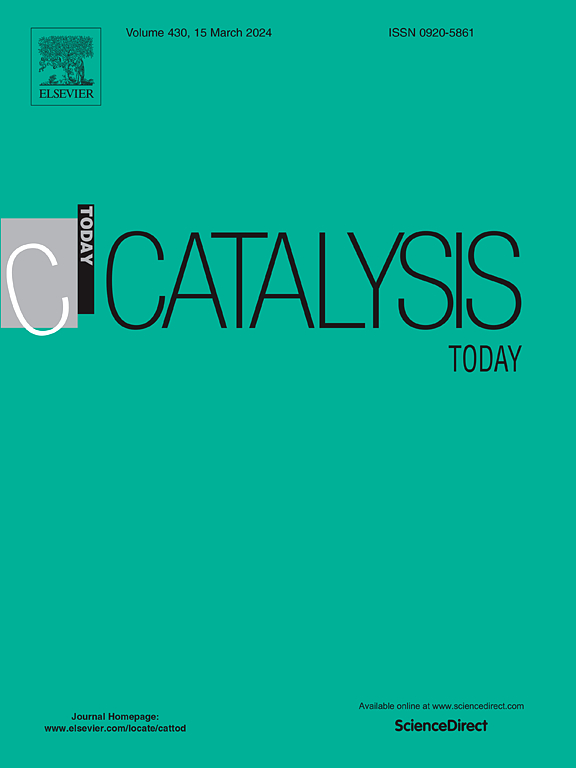用ZnO和CuOx/ZnO薄膜在玻璃和ITO衬底上高效光降解蒸馏水和自来水中的Axetine
IF 5.2
2区 化学
Q1 CHEMISTRY, APPLIED
引用次数: 0
摘要
本文合成了ZnO和CuOx/ZnO溶胶-凝胶膜,并将其作为紫外照射的光催化剂。该合成过程简单且环保,首次利用紫外光照射将CuOx离子光固定在ZnO薄膜上。光固定包括通过紫外线光沉积使表面功能化。利用浸涂技术,将ZnO和CuOx/ZnO薄膜沉积在氧化铟锡(ITO)和玻璃衬底上。通过对蒸馏水和自来水中Axetine的降解,评价了新膜的光催化效率。ITO上的溶胶-凝胶膜比玻璃基板上的膜表现出更高的光催化效率。表面形貌、界面晶格失配、电荷转移和结晶度的差异可以解释薄膜效率的变化。此外,ZnO带隙中受体能级的形成提高了光生电子-空穴对的分离效率,解释了CuOx/ZnO辐照的光谱范围扩大到可见光区域的原因。CuOx通过生成超活性氧自由基O2•-来增强光活性。此外,经过三个循环使用后,四种类型的溶胶-凝胶膜都保持了光催化活性,这表明它们在处理制药废水方面具有潜在的用途。本文章由计算机程序翻译,如有差异,请以英文原文为准。
Efficient photodegradation of Axetine in distilled and tap water by ZnO and CuOx/ZnO films on glass and ITO substrates
In this work, ZnO and CuOx/ZnO sol-gel films are synthesized and employed as photocatalysts for ultraviolet irradiation. The synthesis procedure is straightforward and eco-friendly, based on the photo-fixation of CuOx ions onto ZnO films via UV illumination for the first time. Photofixation involves surface functionalization through photodeposition using ultraviolet light. Utilizing the dip-coating technique, ZnO and CuOx/ZnO films are deposited on indium tin oxide (ITO) and glass substrates. The photocatalytic efficiency of the newly developed films is assessed through the degradation of Axetine in distilled and tap water. Sol-gel films on ITO demonstrate greater photocatalytic efficiency compared to those on glass substrates. Differences in surface morphology, interfacial lattice mismatch, charge transfer, and crystallinity can account for the variations in film efficiencies. Furthermore, the formation of acceptor levels in the ZnO band gap enhances the efficiency of separating photogenerated electron-hole pairs, explaining the broadening of the spectral range of CuOx/ZnO irradiation into the visible region. CuOx enhances photoactivity by generating the hyperactive oxygen radical O2•–. Additionally, after three cycles of use, all four types of sol-gel films maintained their photocatalytic activity, indicating their potential usefulness in the treatment of pharmaceutical wastewater.
求助全文
通过发布文献求助,成功后即可免费获取论文全文。
去求助
来源期刊

Catalysis Today
化学-工程:化工
CiteScore
11.50
自引率
3.80%
发文量
573
审稿时长
2.9 months
期刊介绍:
Catalysis Today focuses on the rapid publication of original invited papers devoted to currently important topics in catalysis and related subjects. The journal only publishes special issues (Proposing a Catalysis Today Special Issue), each of which is supervised by Guest Editors who recruit individual papers and oversee the peer review process. Catalysis Today offers researchers in the field of catalysis in-depth overviews of topical issues.
Both fundamental and applied aspects of catalysis are covered. Subjects such as catalysis of immobilized organometallic and biocatalytic systems are welcome. Subjects related to catalysis such as experimental techniques, adsorption, process technology, synthesis, in situ characterization, computational, theoretical modeling, imaging and others are included if there is a clear relationship to catalysis.
 求助内容:
求助内容: 应助结果提醒方式:
应助结果提醒方式:


